Article Review: Acupuncture for Knee Osteoarthritis - Study Analysis
VerifiedAdded on 2020/03/04
|8
|1960
|48
Report
AI Summary
This report provides a comprehensive review of an article from the journal Arthritis Care and Research, which investigates the efficacy of acupuncture for knee osteoarthritis. The study, a randomized controlled trial, examines the impact of acupuncturist communication styles and compares traditional Chinese acupuncture (TCA) with sham acupuncture. The review details the study's methodology, including the training of acupuncturists, patient randomization, and the use of electro acupuncture. The results section presents statistical findings from various tables, comparing the outcomes of TCA and sham acupuncture across different communication styles and time periods. The review highlights that while TCA did not prove superior to sham acupuncture, communication interventions did have a small but significant effect on patient satisfaction and pain alleviation. The report concludes by emphasizing the study's unique contribution to understanding the impact of acupuncture for arthritis and its implications for patient care, emphasizing the safety and effectiveness of acupuncture for pain management.
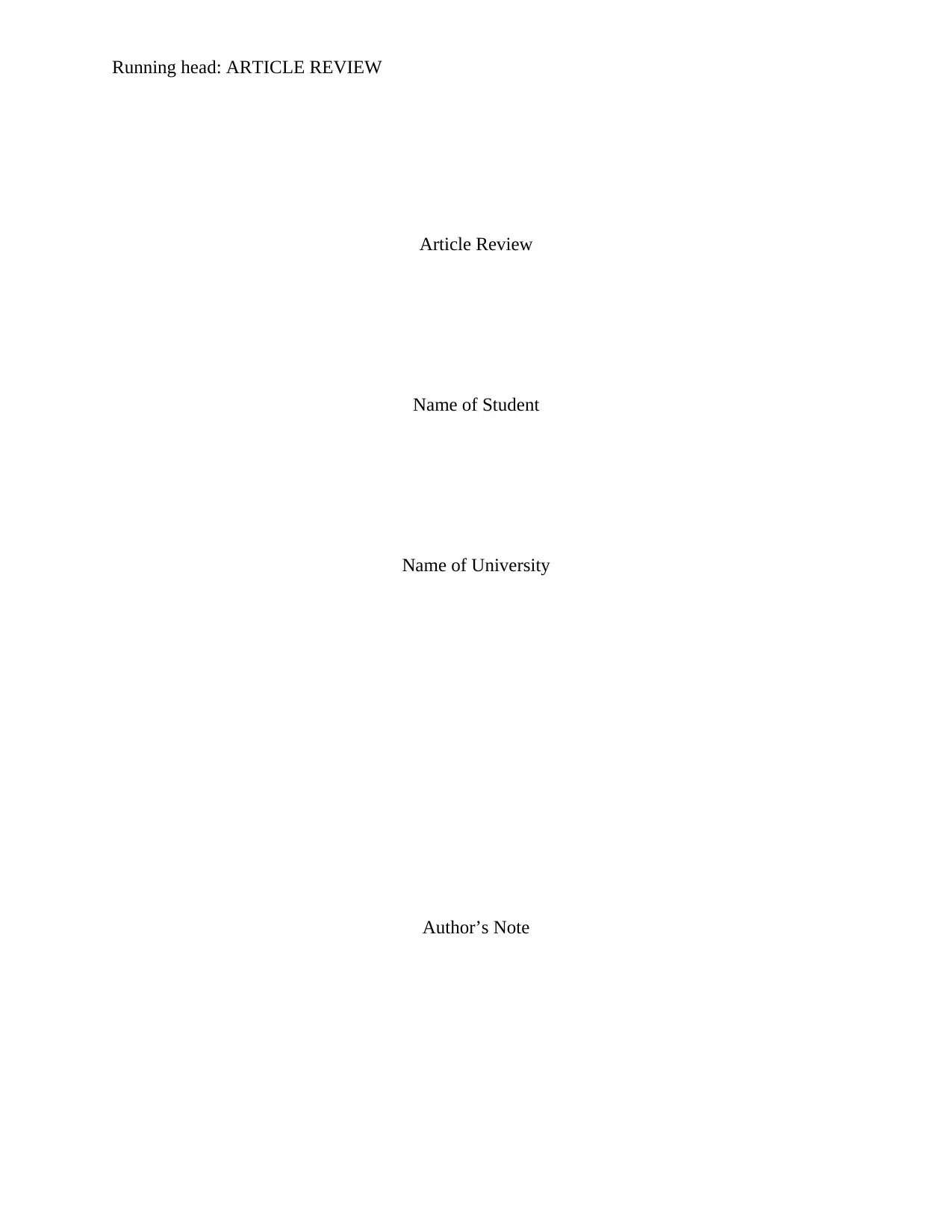
Running head: ARTICLE REVIEW
Article Review
Name of Student
Name of University
Author’s Note
Article Review
Name of Student
Name of University
Author’s Note
Paraphrase This Document
Need a fresh take? Get an instant paraphrase of this document with our AI Paraphraser
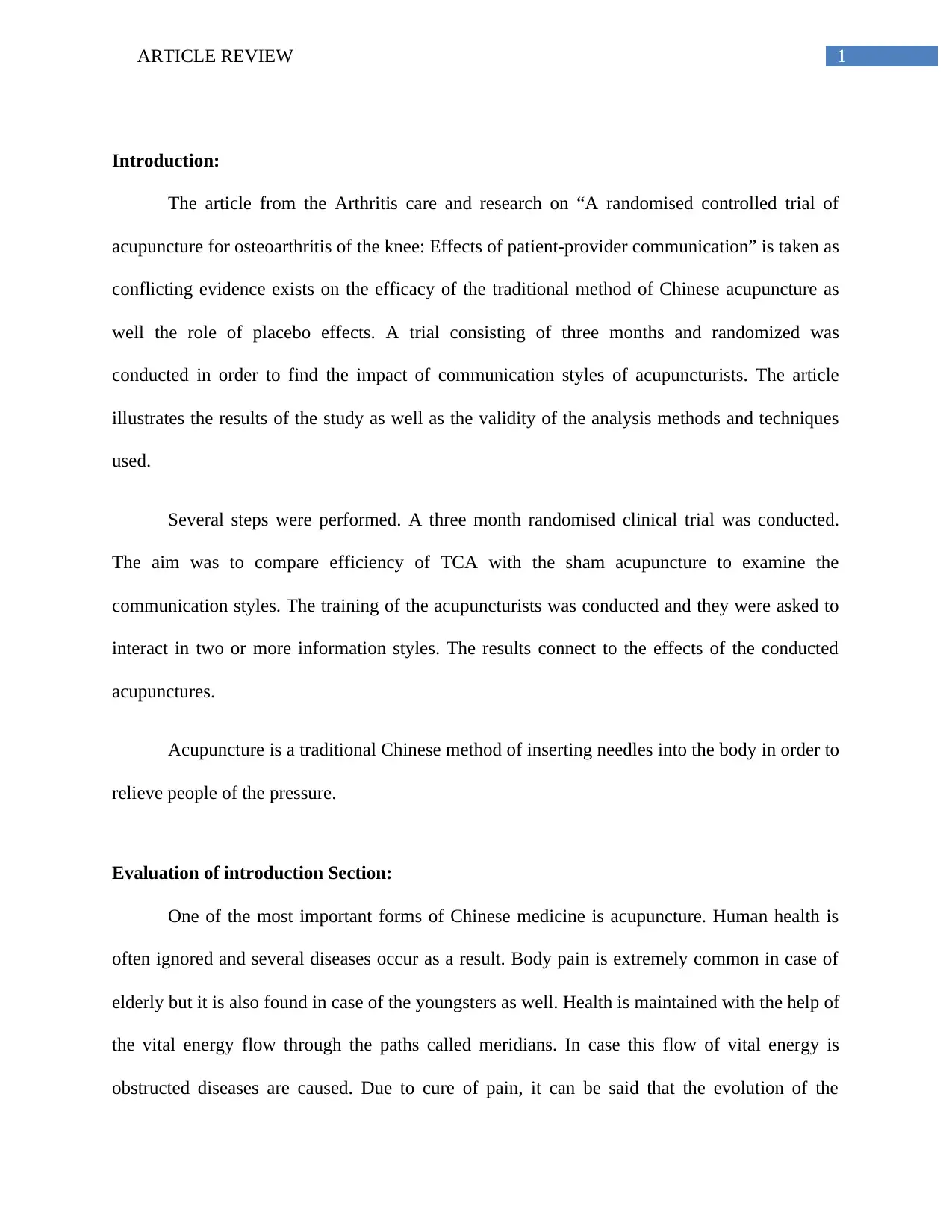
1ARTICLE REVIEW
Introduction:
The article from the Arthritis care and research on “A randomised controlled trial of
acupuncture for osteoarthritis of the knee: Effects of patient-provider communication” is taken as
conflicting evidence exists on the efficacy of the traditional method of Chinese acupuncture as
well the role of placebo effects. A trial consisting of three months and randomized was
conducted in order to find the impact of communication styles of acupuncturists. The article
illustrates the results of the study as well as the validity of the analysis methods and techniques
used.
Several steps were performed. A three month randomised clinical trial was conducted.
The aim was to compare efficiency of TCA with the sham acupuncture to examine the
communication styles. The training of the acupuncturists was conducted and they were asked to
interact in two or more information styles. The results connect to the effects of the conducted
acupunctures.
Acupuncture is a traditional Chinese method of inserting needles into the body in order to
relieve people of the pressure.
Evaluation of introduction Section:
One of the most important forms of Chinese medicine is acupuncture. Human health is
often ignored and several diseases occur as a result. Body pain is extremely common in case of
elderly but it is also found in case of the youngsters as well. Health is maintained with the help of
the vital energy flow through the paths called meridians. In case this flow of vital energy is
obstructed diseases are caused. Due to cure of pain, it can be said that the evolution of the
Introduction:
The article from the Arthritis care and research on “A randomised controlled trial of
acupuncture for osteoarthritis of the knee: Effects of patient-provider communication” is taken as
conflicting evidence exists on the efficacy of the traditional method of Chinese acupuncture as
well the role of placebo effects. A trial consisting of three months and randomized was
conducted in order to find the impact of communication styles of acupuncturists. The article
illustrates the results of the study as well as the validity of the analysis methods and techniques
used.
Several steps were performed. A three month randomised clinical trial was conducted.
The aim was to compare efficiency of TCA with the sham acupuncture to examine the
communication styles. The training of the acupuncturists was conducted and they were asked to
interact in two or more information styles. The results connect to the effects of the conducted
acupunctures.
Acupuncture is a traditional Chinese method of inserting needles into the body in order to
relieve people of the pressure.
Evaluation of introduction Section:
One of the most important forms of Chinese medicine is acupuncture. Human health is
often ignored and several diseases occur as a result. Body pain is extremely common in case of
elderly but it is also found in case of the youngsters as well. Health is maintained with the help of
the vital energy flow through the paths called meridians. In case this flow of vital energy is
obstructed diseases are caused. Due to cure of pain, it can be said that the evolution of the

2ARTICLE REVIEW
acupuncture technique has been huge. The modes of acupuncture have changed gradually from
manual stimulation of the past to the electro acupuncture. The number of clinical randomised
trials in the theory of efficacy of acupuncture is only two in number. The impact of acupuncture
in case of knee arthritis is very varied. There may be expectations of improvement in the fields of
acupuncture. There are two communication styles discussed in the question. In order to
understand the contribution of the different communication styles corresponding to the responses
which are therapeutic in nature, a randomised trial was performed. A nested factorial design was
also used to understand the effects of the communication styles of the acupuncturists.
Evaluation of methods section:
The methods section has been segregated into several parts which clearly explain the
methods utilised to determine the effects of the behaviour of the persons practicing acupuncture
as well as the patient’s responses to the different natures of the Chinese medicine. The aim is
also to clearly understand the differences between the two different modes of the medicine.
At first for a basic assessment of the people, the patients were divided into three groups
consists of waiting list, high expectations or neutral expectations. To ensure that the results were
genuine, six special acupuncturists were trained as well as their experiences were also checked.
After this the randomisation of the patients were again performed and they were asked to be
treated in any one of the two styles of either the Traditional Chinese or the Sham Acupuncture. It
is also to be noted that all the techniques and methods used were appreciated by the Review
Boards as well as special and genuine health care centres.
Randomisation:
acupuncture technique has been huge. The modes of acupuncture have changed gradually from
manual stimulation of the past to the electro acupuncture. The number of clinical randomised
trials in the theory of efficacy of acupuncture is only two in number. The impact of acupuncture
in case of knee arthritis is very varied. There may be expectations of improvement in the fields of
acupuncture. There are two communication styles discussed in the question. In order to
understand the contribution of the different communication styles corresponding to the responses
which are therapeutic in nature, a randomised trial was performed. A nested factorial design was
also used to understand the effects of the communication styles of the acupuncturists.
Evaluation of methods section:
The methods section has been segregated into several parts which clearly explain the
methods utilised to determine the effects of the behaviour of the persons practicing acupuncture
as well as the patient’s responses to the different natures of the Chinese medicine. The aim is
also to clearly understand the differences between the two different modes of the medicine.
At first for a basic assessment of the people, the patients were divided into three groups
consists of waiting list, high expectations or neutral expectations. To ensure that the results were
genuine, six special acupuncturists were trained as well as their experiences were also checked.
After this the randomisation of the patients were again performed and they were asked to be
treated in any one of the two styles of either the Traditional Chinese or the Sham Acupuncture. It
is also to be noted that all the techniques and methods used were appreciated by the Review
Boards as well as special and genuine health care centres.
Randomisation:
⊘ This is a preview!⊘
Do you want full access?
Subscribe today to unlock all pages.

Trusted by 1+ million students worldwide
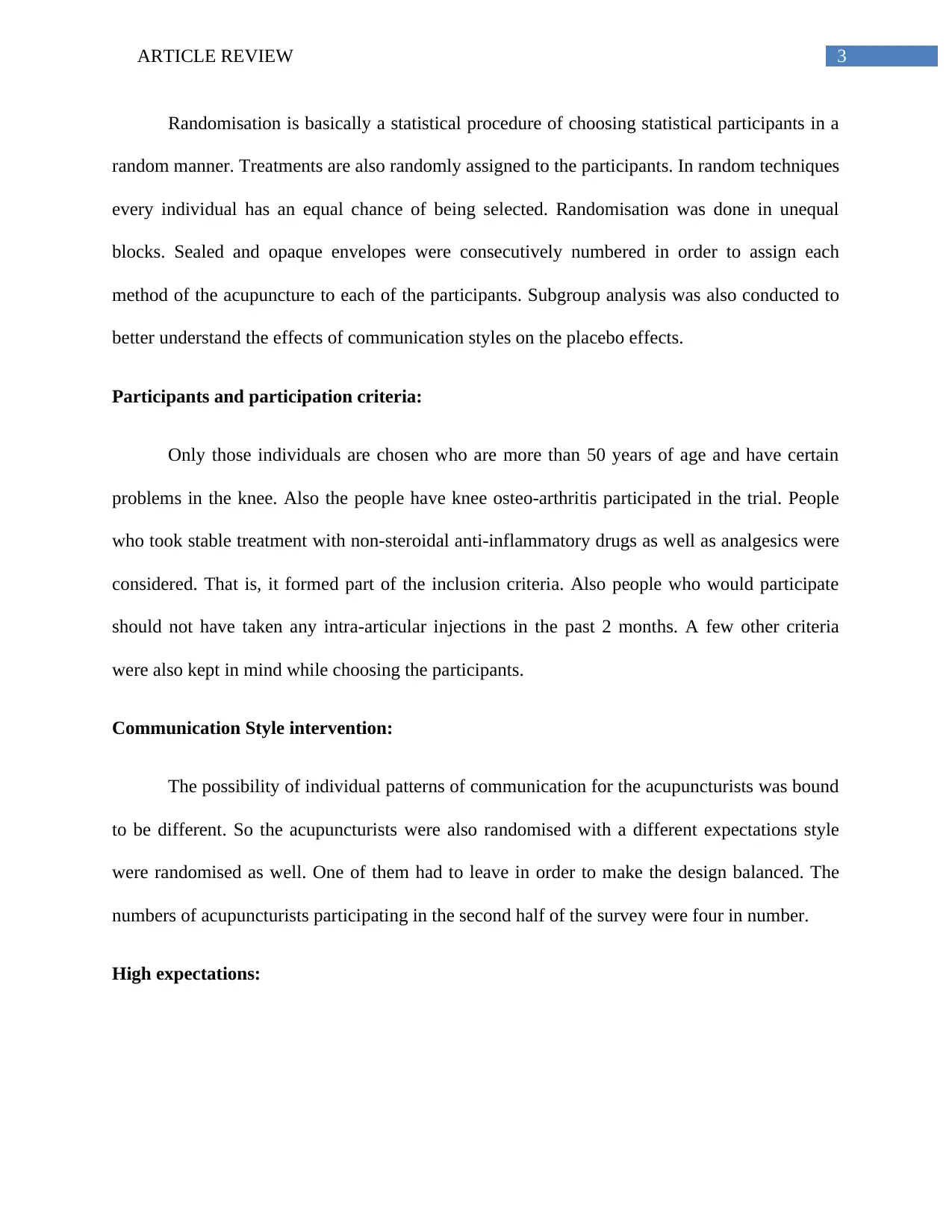
3ARTICLE REVIEW
Randomisation is basically a statistical procedure of choosing statistical participants in a
random manner. Treatments are also randomly assigned to the participants. In random techniques
every individual has an equal chance of being selected. Randomisation was done in unequal
blocks. Sealed and opaque envelopes were consecutively numbered in order to assign each
method of the acupuncture to each of the participants. Subgroup analysis was also conducted to
better understand the effects of communication styles on the placebo effects.
Participants and participation criteria:
Only those individuals are chosen who are more than 50 years of age and have certain
problems in the knee. Also the people have knee osteo-arthritis participated in the trial. People
who took stable treatment with non-steroidal anti-inflammatory drugs as well as analgesics were
considered. That is, it formed part of the inclusion criteria. Also people who would participate
should not have taken any intra-articular injections in the past 2 months. A few other criteria
were also kept in mind while choosing the participants.
Communication Style intervention:
The possibility of individual patterns of communication for the acupuncturists was bound
to be different. So the acupuncturists were also randomised with a different expectations style
were randomised as well. One of them had to leave in order to make the design balanced. The
numbers of acupuncturists participating in the second half of the survey were four in number.
High expectations:
Randomisation is basically a statistical procedure of choosing statistical participants in a
random manner. Treatments are also randomly assigned to the participants. In random techniques
every individual has an equal chance of being selected. Randomisation was done in unequal
blocks. Sealed and opaque envelopes were consecutively numbered in order to assign each
method of the acupuncture to each of the participants. Subgroup analysis was also conducted to
better understand the effects of communication styles on the placebo effects.
Participants and participation criteria:
Only those individuals are chosen who are more than 50 years of age and have certain
problems in the knee. Also the people have knee osteo-arthritis participated in the trial. People
who took stable treatment with non-steroidal anti-inflammatory drugs as well as analgesics were
considered. That is, it formed part of the inclusion criteria. Also people who would participate
should not have taken any intra-articular injections in the past 2 months. A few other criteria
were also kept in mind while choosing the participants.
Communication Style intervention:
The possibility of individual patterns of communication for the acupuncturists was bound
to be different. So the acupuncturists were also randomised with a different expectations style
were randomised as well. One of them had to leave in order to make the design balanced. The
numbers of acupuncturists participating in the second half of the survey were four in number.
High expectations:
Paraphrase This Document
Need a fresh take? Get an instant paraphrase of this document with our AI Paraphraser
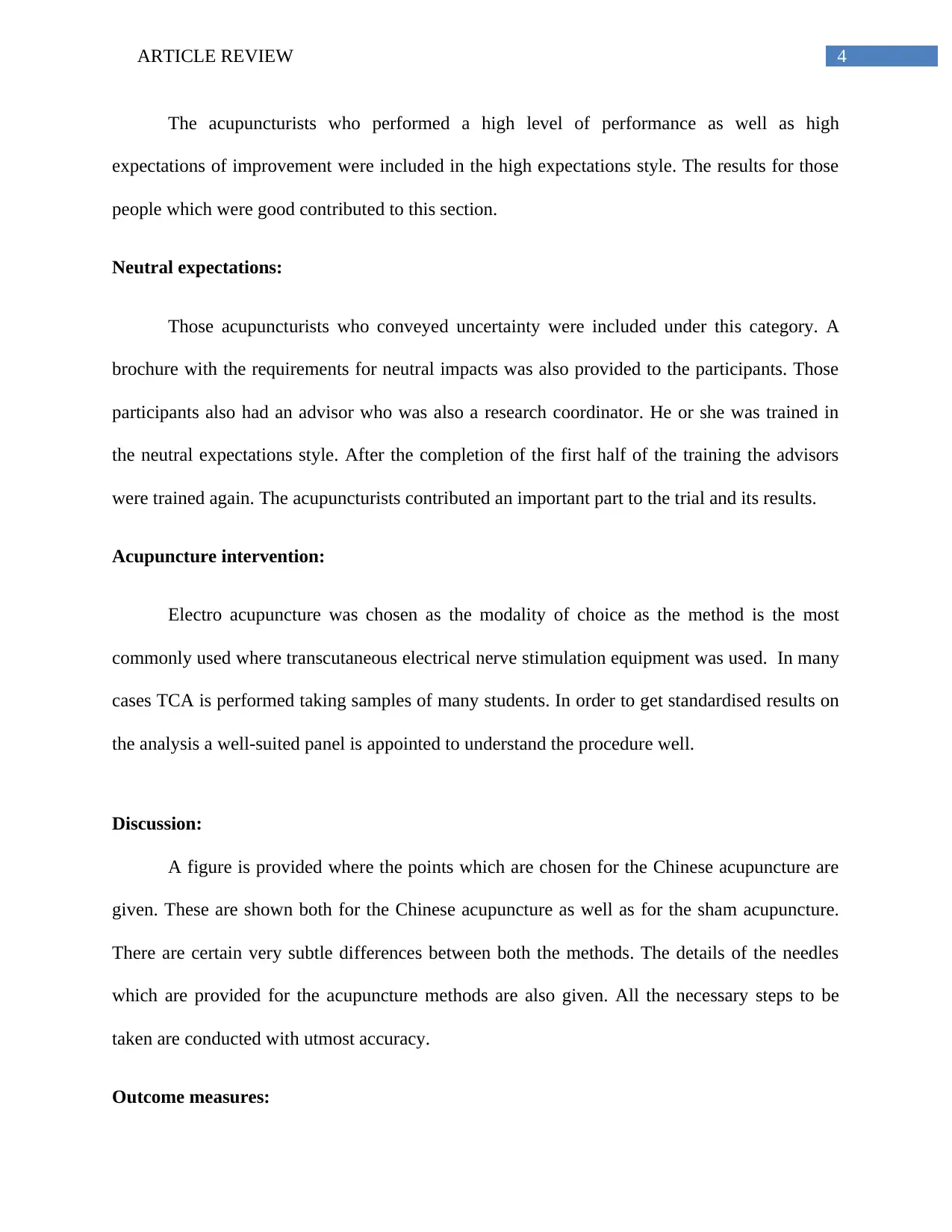
4ARTICLE REVIEW
The acupuncturists who performed a high level of performance as well as high
expectations of improvement were included in the high expectations style. The results for those
people which were good contributed to this section.
Neutral expectations:
Those acupuncturists who conveyed uncertainty were included under this category. A
brochure with the requirements for neutral impacts was also provided to the participants. Those
participants also had an advisor who was also a research coordinator. He or she was trained in
the neutral expectations style. After the completion of the first half of the training the advisors
were trained again. The acupuncturists contributed an important part to the trial and its results.
Acupuncture intervention:
Electro acupuncture was chosen as the modality of choice as the method is the most
commonly used where transcutaneous electrical nerve stimulation equipment was used. In many
cases TCA is performed taking samples of many students. In order to get standardised results on
the analysis a well-suited panel is appointed to understand the procedure well.
Discussion:
A figure is provided where the points which are chosen for the Chinese acupuncture are
given. These are shown both for the Chinese acupuncture as well as for the sham acupuncture.
There are certain very subtle differences between both the methods. The details of the needles
which are provided for the acupuncture methods are also given. All the necessary steps to be
taken are conducted with utmost accuracy.
Outcome measures:
The acupuncturists who performed a high level of performance as well as high
expectations of improvement were included in the high expectations style. The results for those
people which were good contributed to this section.
Neutral expectations:
Those acupuncturists who conveyed uncertainty were included under this category. A
brochure with the requirements for neutral impacts was also provided to the participants. Those
participants also had an advisor who was also a research coordinator. He or she was trained in
the neutral expectations style. After the completion of the first half of the training the advisors
were trained again. The acupuncturists contributed an important part to the trial and its results.
Acupuncture intervention:
Electro acupuncture was chosen as the modality of choice as the method is the most
commonly used where transcutaneous electrical nerve stimulation equipment was used. In many
cases TCA is performed taking samples of many students. In order to get standardised results on
the analysis a well-suited panel is appointed to understand the procedure well.
Discussion:
A figure is provided where the points which are chosen for the Chinese acupuncture are
given. These are shown both for the Chinese acupuncture as well as for the sham acupuncture.
There are certain very subtle differences between both the methods. The details of the needles
which are provided for the acupuncture methods are also given. All the necessary steps to be
taken are conducted with utmost accuracy.
Outcome measures:

5ARTICLE REVIEW
The outcome measures were collected at baseline, then four weeks, six weeks and finally
three months after treatment. The point worth noting regarding this analysis is that no stone was
left unturned to ensure the unbiasedness of the procedure. The key words were not used in order
to obtain an unbiased approach. The patients after several periods of treatment were asked
whether they noticed positive effects from the treatments they received or not.
One of the most accurate measures of statistical analysis namely ANOVA or the analysis
of variance was conducted to assess the changes over time and this was done repeatedly over
different time periods.
Evaluation of Results Section:
In the results section we are provided with several tables indicating the statistical results
of the conducted surveys as well as the experiments. The total sample number denoted by n has
the value of 580. Out of this total number the number of participants randomised in the high
expectations group was 238. The number randomised in the neutral expectations group was 242
and finally in the waiting list group the number was 80. The subsequent removals as well as
additions were also mentioned.
The first table shows the baseline demographic as well as the clinical characteristics of
the participants as well as their division into various groups was shown. This was done on the
basis of educational degree, the nature of origin, educational level as well as the nature of the
medications given. It can been seen that not much of a significant difference was observed
between the two acupuncture groups.
The next table shows the measures of outcome by the acupuncture treatment group.
Every nature of collected outcome for specific time periods including baseline, 4 weeks, 6 weeks
The outcome measures were collected at baseline, then four weeks, six weeks and finally
three months after treatment. The point worth noting regarding this analysis is that no stone was
left unturned to ensure the unbiasedness of the procedure. The key words were not used in order
to obtain an unbiased approach. The patients after several periods of treatment were asked
whether they noticed positive effects from the treatments they received or not.
One of the most accurate measures of statistical analysis namely ANOVA or the analysis
of variance was conducted to assess the changes over time and this was done repeatedly over
different time periods.
Evaluation of Results Section:
In the results section we are provided with several tables indicating the statistical results
of the conducted surveys as well as the experiments. The total sample number denoted by n has
the value of 580. Out of this total number the number of participants randomised in the high
expectations group was 238. The number randomised in the neutral expectations group was 242
and finally in the waiting list group the number was 80. The subsequent removals as well as
additions were also mentioned.
The first table shows the baseline demographic as well as the clinical characteristics of
the participants as well as their division into various groups was shown. This was done on the
basis of educational degree, the nature of origin, educational level as well as the nature of the
medications given. It can been seen that not much of a significant difference was observed
between the two acupuncture groups.
The next table shows the measures of outcome by the acupuncture treatment group.
Every nature of collected outcome for specific time periods including baseline, 4 weeks, 6 weeks
⊘ This is a preview!⊘
Do you want full access?
Subscribe today to unlock all pages.

Trusted by 1+ million students worldwide
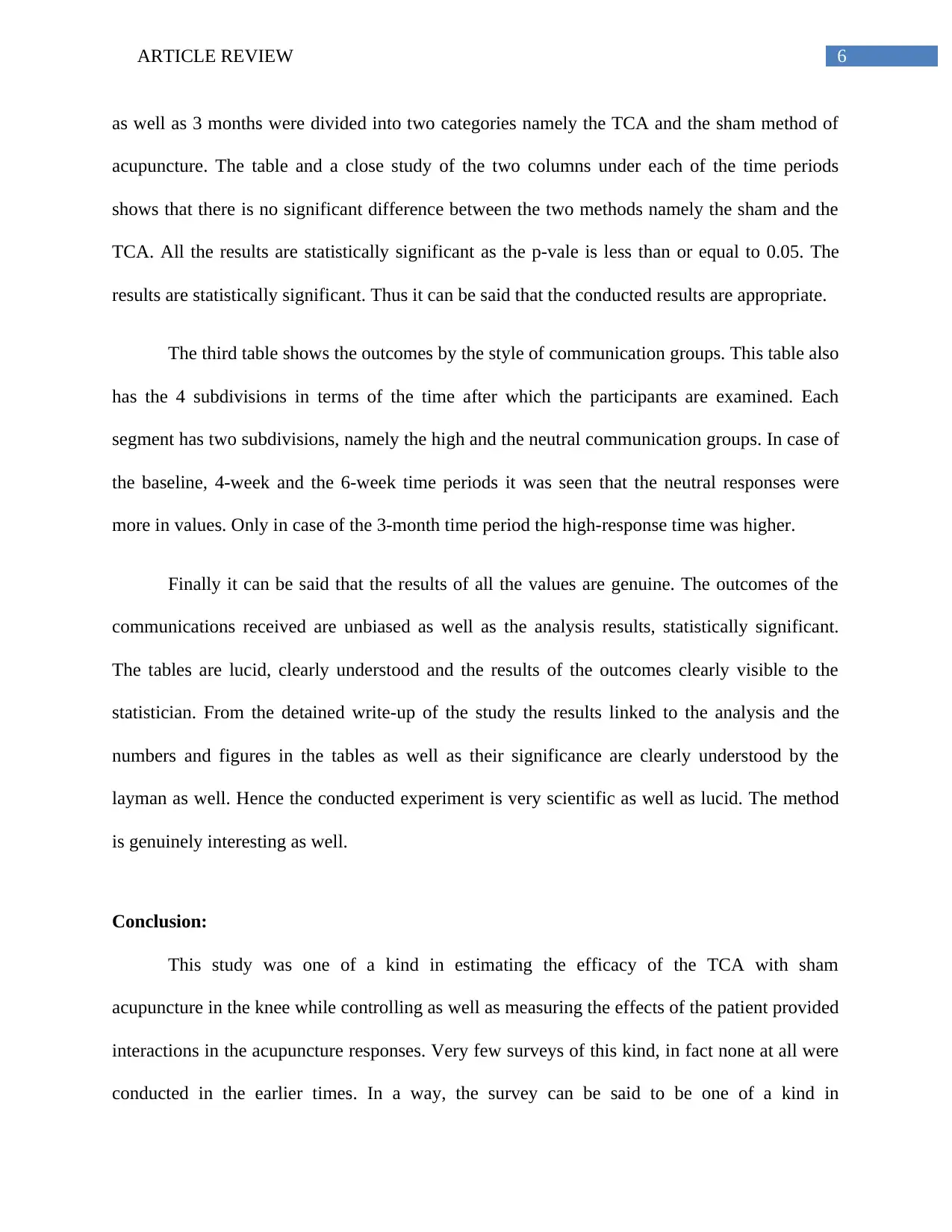
6ARTICLE REVIEW
as well as 3 months were divided into two categories namely the TCA and the sham method of
acupuncture. The table and a close study of the two columns under each of the time periods
shows that there is no significant difference between the two methods namely the sham and the
TCA. All the results are statistically significant as the p-vale is less than or equal to 0.05. The
results are statistically significant. Thus it can be said that the conducted results are appropriate.
The third table shows the outcomes by the style of communication groups. This table also
has the 4 subdivisions in terms of the time after which the participants are examined. Each
segment has two subdivisions, namely the high and the neutral communication groups. In case of
the baseline, 4-week and the 6-week time periods it was seen that the neutral responses were
more in values. Only in case of the 3-month time period the high-response time was higher.
Finally it can be said that the results of all the values are genuine. The outcomes of the
communications received are unbiased as well as the analysis results, statistically significant.
The tables are lucid, clearly understood and the results of the outcomes clearly visible to the
statistician. From the detained write-up of the study the results linked to the analysis and the
numbers and figures in the tables as well as their significance are clearly understood by the
layman as well. Hence the conducted experiment is very scientific as well as lucid. The method
is genuinely interesting as well.
Conclusion:
This study was one of a kind in estimating the efficacy of the TCA with sham
acupuncture in the knee while controlling as well as measuring the effects of the patient provided
interactions in the acupuncture responses. Very few surveys of this kind, in fact none at all were
conducted in the earlier times. In a way, the survey can be said to be one of a kind in
as well as 3 months were divided into two categories namely the TCA and the sham method of
acupuncture. The table and a close study of the two columns under each of the time periods
shows that there is no significant difference between the two methods namely the sham and the
TCA. All the results are statistically significant as the p-vale is less than or equal to 0.05. The
results are statistically significant. Thus it can be said that the conducted results are appropriate.
The third table shows the outcomes by the style of communication groups. This table also
has the 4 subdivisions in terms of the time after which the participants are examined. Each
segment has two subdivisions, namely the high and the neutral communication groups. In case of
the baseline, 4-week and the 6-week time periods it was seen that the neutral responses were
more in values. Only in case of the 3-month time period the high-response time was higher.
Finally it can be said that the results of all the values are genuine. The outcomes of the
communications received are unbiased as well as the analysis results, statistically significant.
The tables are lucid, clearly understood and the results of the outcomes clearly visible to the
statistician. From the detained write-up of the study the results linked to the analysis and the
numbers and figures in the tables as well as their significance are clearly understood by the
layman as well. Hence the conducted experiment is very scientific as well as lucid. The method
is genuinely interesting as well.
Conclusion:
This study was one of a kind in estimating the efficacy of the TCA with sham
acupuncture in the knee while controlling as well as measuring the effects of the patient provided
interactions in the acupuncture responses. Very few surveys of this kind, in fact none at all were
conducted in the earlier times. In a way, the survey can be said to be one of a kind in
Paraphrase This Document
Need a fresh take? Get an instant paraphrase of this document with our AI Paraphraser
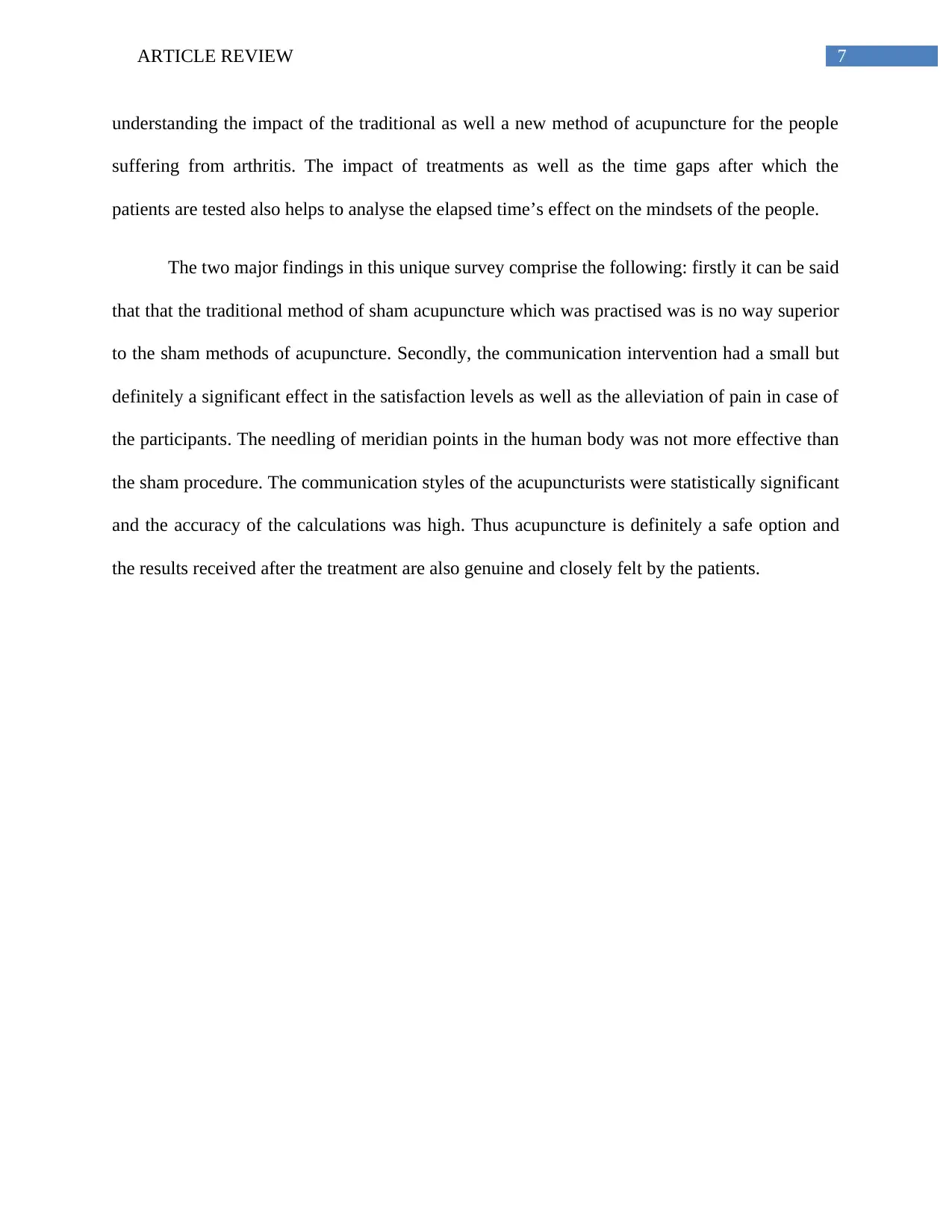
7ARTICLE REVIEW
understanding the impact of the traditional as well a new method of acupuncture for the people
suffering from arthritis. The impact of treatments as well as the time gaps after which the
patients are tested also helps to analyse the elapsed time’s effect on the mindsets of the people.
The two major findings in this unique survey comprise the following: firstly it can be said
that that the traditional method of sham acupuncture which was practised was is no way superior
to the sham methods of acupuncture. Secondly, the communication intervention had a small but
definitely a significant effect in the satisfaction levels as well as the alleviation of pain in case of
the participants. The needling of meridian points in the human body was not more effective than
the sham procedure. The communication styles of the acupuncturists were statistically significant
and the accuracy of the calculations was high. Thus acupuncture is definitely a safe option and
the results received after the treatment are also genuine and closely felt by the patients.
understanding the impact of the traditional as well a new method of acupuncture for the people
suffering from arthritis. The impact of treatments as well as the time gaps after which the
patients are tested also helps to analyse the elapsed time’s effect on the mindsets of the people.
The two major findings in this unique survey comprise the following: firstly it can be said
that that the traditional method of sham acupuncture which was practised was is no way superior
to the sham methods of acupuncture. Secondly, the communication intervention had a small but
definitely a significant effect in the satisfaction levels as well as the alleviation of pain in case of
the participants. The needling of meridian points in the human body was not more effective than
the sham procedure. The communication styles of the acupuncturists were statistically significant
and the accuracy of the calculations was high. Thus acupuncture is definitely a safe option and
the results received after the treatment are also genuine and closely felt by the patients.
1 out of 8
Related Documents
Your All-in-One AI-Powered Toolkit for Academic Success.
+13062052269
info@desklib.com
Available 24*7 on WhatsApp / Email
![[object Object]](/_next/static/media/star-bottom.7253800d.svg)
Unlock your academic potential
Copyright © 2020–2025 A2Z Services. All Rights Reserved. Developed and managed by ZUCOL.





